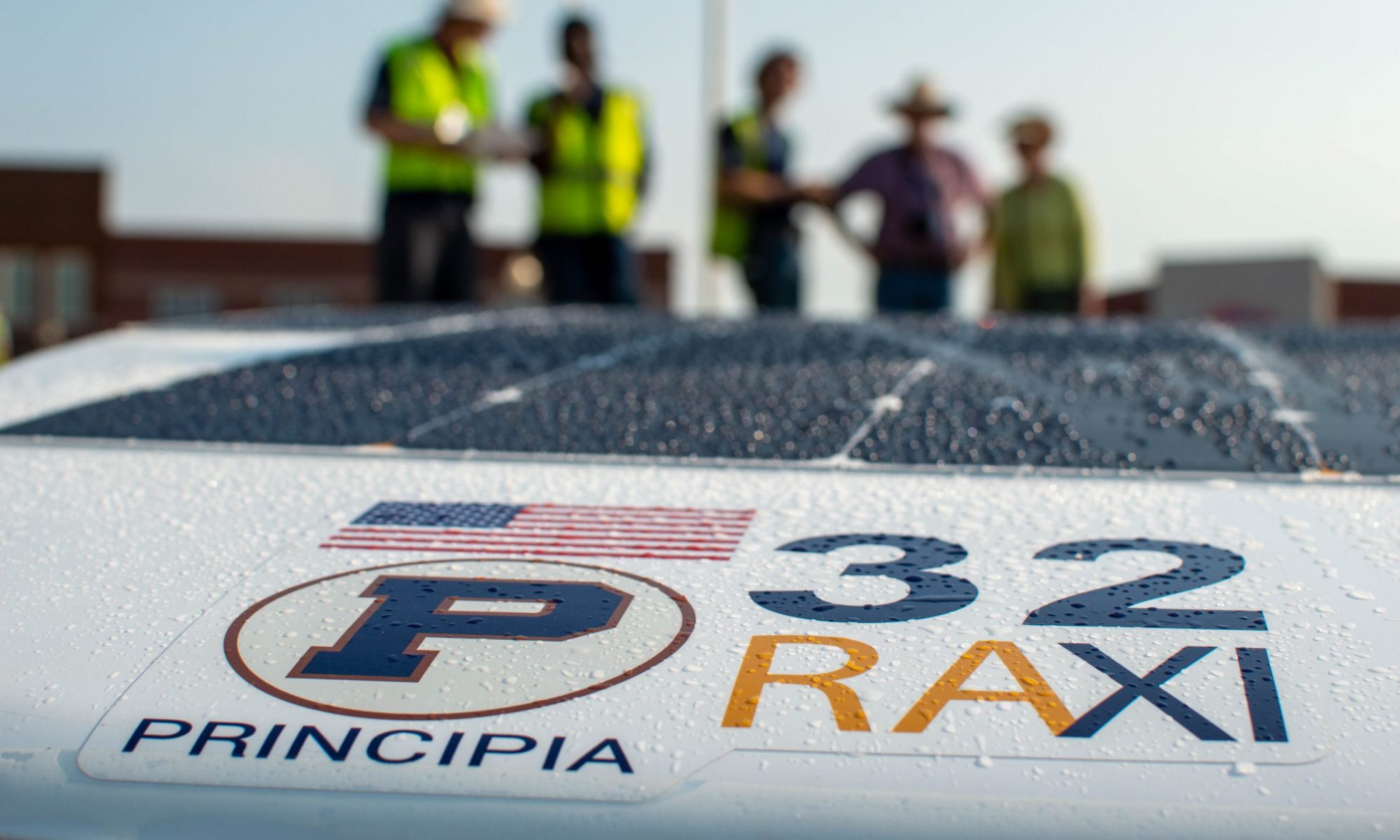“Step on the gas! It’s the cops!”
But there’s no gas in a solar car. So, “Step on the battery!”
That doesn’t have the same ring. Especially, if the cops are insistent.
Within a matter of miles, RA XI was “introduced” to local law enforcement twice. A note of context is important. It’s a rare sight in southwestern Kansas to see strange vehicles, bracketed by cars or vans plastered with stickers and carrying flashing lights. Cars will pull alongside, pacing the convoy, taking pictures until an oversized gloved hand waves the sightseers away from the vehicles—bright green gloves for the lead driver and shotgun, bright orange ones for the chase car driver. At construction sites and roadblocks, workers will often pull out their cellphones and take pictures.
Since the U.S. Defense Department has admitted the existence of UFOs, it’s now okay to admit that they look like solar cars.
Twice, on either side of a county line, local county police or sheriff’s deputies pulled over the RA XI caravan. License, registration, proof of insurance?
“What’s the problem, officer?” We’re not speeding. A two lane black top in southwestern Kansas has posted speed limits of 65 and 70 mph, and these farmers are not slow. So, it might be the opposite problem, with “target speeds” in the high 30s or 40s. Teams can get deductions if they hold up traffic and that’s more painful than a ticket for “not speeding.”
The officers were a mixture of curious, concerned, and conversational. Be careful, though, of explaining that you are part of “a race,” unless you want to warn the officers that there are more solar cars coming. Wait until you see that car from Minnesota!
The morning started off with less drama, though. Although Principia was first to arrive in McPherson the day before, RA XI was a tenth of a mile behind the leader, MIT (this is an endurance race, not a timed race). So on Wednesday morning, MIT took off first. I had the pleasure of introducing myself to the MIT team and assured them that Principia “had their back.”
Somehow, that didn’t sound as reassuring. It’s like the warning on your rearview mirror— “Objects are closer than they appear,”—when they are only a tenth of a mile behind.
It was less than 25 minutes to start and panic strikes. Earlier, a faulty valve stem threatened to sideline the chase van. The alternative was the “Prez Prius.” While I wanted to wave a bright orange glove at people, I’m not aggressive enough to drive chase. The chase car must bully away threats to the solar car. Fortunately, the valve was quickly replaced.
Then, disaster of another sort struck. Through no fault of the team member, a change of clothes was needed; clothing was soaked. Shorts and underwear needed replacement. If it’s Home Depot or an auto parts store you need, call Steve Shedd. But who do you call for “fresh underwear?”
In minutes, I’m standing in Walmart as my wife asks the important question—boxers or briefs? “What? This is a race! Does it really matter?” (Of course, it does.)
Thank goodness for texting. We double checked the waist size. Nylon or cotton? How about the style? Which color . . . STOP! “This is a race!” Once RA XI is flagged onto the highway, the best we can do is drive along side and toss underwear at the convoy. A big orange glove would be useful but that would get police attention.
MIT is called to the starting line for countdown, and the Principia convoy is readied. The lead van and chase van are pulled into position, ready to cocoon RA XI. The least significant RA XI team support vehicle—yes, the Prez Prius is an official team vehicle, covered with solar stickers and Principia promotions—whips into the starting pits, avoiding MIT and inattentive spectators. With the bag of vital materials in hand, the First Lady dashes to the vans and tosses the bag into the . . . wait, which van needs the underwear—lead or chase?
RA XI is waved into position. The countdown occurs, and the convoy launches into traffic. In a few moments, a grateful text comes through. Mission accomplished. We got the right van.
The teams drive on one route and support vehicles are usually are assigned a different, somewhat parallel route. As a result, we can leave after the convoy yet beat the team to the next stop. So, on Wednesday, the Prez Prius and the truck and trailer hopscotched back and forth on the alternate route. We drove through Hutchinson and arrived in Dodge City, Kansas (right behind the Boot Hill Museum) ahead of everyone but the race organizers.
We had enough time for lunch and wandered to the arrival area. The first car had already arrived. It’s a special competition car (only two in the class) for multiple occupants. These cars have different rules, including access to plug-in recharging. The lead car from University of Minnesota Twin Cities looks like an elephant had stepped on a Humvee. It’s big, broad, squatty, and solid and can hold four people.
As we’re admiring the closest thing to a solar car monster, in rolls RA XI. We were so unprepared that the President was called upon to “stand on the tarp” and hope the brakes work. The support vehicle drivers prepare the parking spot with plastic tarp; an extra body was needed to hold it down against the Great Plains winds. Once the car is in place, the team can crawl under the car for inspections or repairs and catch any loose parts—nuts, bolts, carburetor (that’s expendable on a solar car), pink string, etc.
Pink string? That was the topic of chatter on the group text for the next hour or so. Maybe that’s what interested the cops. The string needed to be investigated and removed.
The stop was for a mandatory 45 minutes, and Principia’s team was eager to get back on the road. If you make good time, you can accrue additional laps at a subsequent stop. Remember, it is a primarily an endurance race.
Twenty-eight minutes behind RA XI was the MIT car. Their car is top of class and could have been pulled over for speeding. On the other hand, they could be pacing their car since time is only of secondary importance.
The afternoon was challenging as a storm front swept across the Kansas-Colorado state line. The temperature dropped from 90 to 65 degrees. Rain is not good for solar cars. Isn’t that obvious? “All drain, no gain” (running in the rain or with clouds drains the battery without any energy gain from the sun). Also, our electronics and electrical systems haven’t been “rain certified.” Just imagine running in the rain, with semi trucks passing within feet at 70 mph. Maybe it would be a good idea to put the car in the trailer and figure out an alternate strategy.
Wherever you stop for the day (in the cross-country portions of the race), an assigned observer and race official spray paints a line where you stopped. You must start from that spot the next day or suffer additional penalty points that count against your miles. You replenish your miles with additional loops at destination points. So, speed is important in order to be able to cover more distance. But speed eats up your power, which you need to make additional loops. All of this occurs within precisely timed windows.
The scout car headed into the squall line west of Garden City, Kansas, trying to assess the depth of the storm. We were about 20 miles behind as we entered the storm. The truck and trailer pulled off, the convoy arrived, and the car was placed in the trailer.
We caught up with the scout car in eastern Colorado, just short of Lamar. We were on the backside of the storm front, hoping for sunshine. Where should RA XI stop to recharge? At our rendezvous spot, in Lamar, or somewhere else? The scout car raced ahead, and the Prez Prius was assigned to wait for the rest of the team.
We can attest, this part of America is quiet but not empty. We passed massive (and stinky) cattle feed lots. Small rocker arms pump oil from the ground. We drove through an extensive wind turbine complex with probably more than a hundred turbines. And there are many tiny towns with buildings from the mid-1800s and plenty of friendly folks. You pass Sand Hills and a national prairie grass preserve.
Missy and I sat quietly as a local stopped and backed up. He asked with a toothy grin, “Outta gas?” I wanted to reply, “Nope, outta sun,” but wisdom kept my foot out of my mouth. We explained we were waiting for a convoy of vehicles to catch up with us. With a happy wave, the farmer was back on the road. It was so quiet that I did the most inappropriate thing. I called the office. “Well, Dorothy, this may be Kansas, but I’ve got five bars!”
In the meantime, the team decided to press on to Lamar and try “catch rays” there. We looked up as our convoy raced by—at speed limit—lead, truck and trailer (with car inside), chase car, and the Brookes (parents of our drivers). They waved and were gone.
Humm, this place is really quiet. Where are they going? To the hotel? What town?
Thursday morning will start very early as the team must retrace its steps—about an hour’s drive—to start where they had stopped the day before. Wednesday began with a race for underwear and ended with racing the rain. No sign of MIT.


